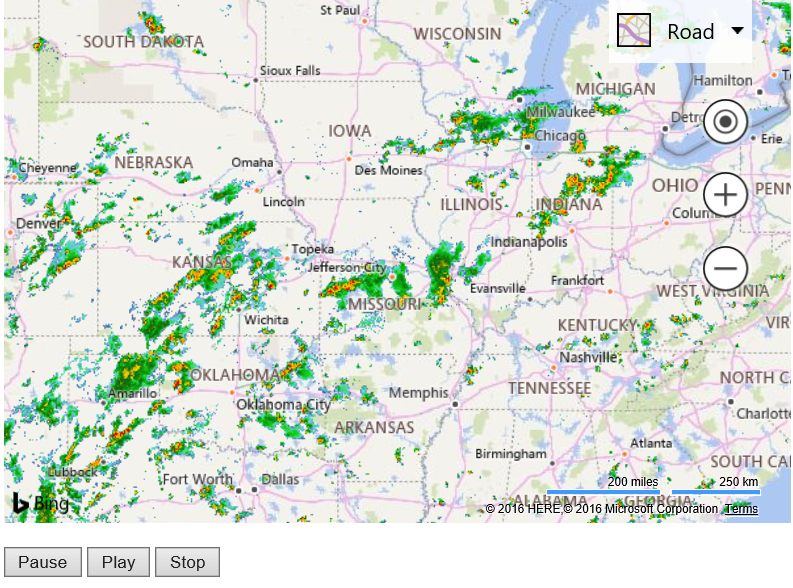Controlling an AnimatedTileLayer
Note
Bing Maps Web Control SDK retirement
Bing Maps Web Control SDK is deprecated and will be retired. Free (Basic) account customers can continue to use Bing Maps Web Control SDK until June 30th, 2025. Enterprise account customers can continue to use Bing Maps Web Control SDK until June 30th, 2028. To avoid service disruptions, all implementations using Bing Maps Web Control SDK will need to be updated to use Azure Maps Web SDK by the retirement date that applies to your Bing Maps for Enterprise account type. For detailed migration guidance, see Migrate from Bing Maps Web Control SDK and Migrate Bing Maps Enterprise applications to Azure Maps with GitHub Copilot.
Azure Maps is Microsoft's next-generation maps and geospatial services for developers. Azure Maps has many of the same features as Bing Maps for Enterprise, and more. To get started with Azure Maps, create a free Azure subscription and an Azure Maps account. For more information about azure Maps, see Azure Maps Documentation. For migration guidance, see Bing Maps Migration Overview.
This example shows how to control an AnimatedTileLayer by using the play, pause and stop functions. For this example the weather radar tile service from the Iowa Environmental Mesonet of Iowa State University and animates it. This service provides radar images for the last 50 minutes over the USA broken up into 5 minute increments.
<!DOCTYPE html>
<html>
<head>
<title></title>
<meta charset="utf-8" />
<script type='text/javascript'>
var map, animatedLayer;
//Weather tile url from Iowa Environmental Mesonet (IEM): https://mesonet.agron.iastate.edu/ogc/
var urlTemplate = 'https://mesonet.agron.iastate.edu/cache/tile.py/1.0.0/nexrad-n0q-{timestamp}/{zoom}/{x}/{y}.png';
//The time stamps values for the IEM service for the last 50 minutes broken up into 5 minute increments.
var timestamps = ['900913-m50m', '900913-m45m', '900913-m40m', '900913-m35m', '900913-m30m', '900913-m25m', '900913-m20m', '900913-m15m', '900913-m10m', '900913-m05m', '900913'];
function GetMap()
{
map = new Microsoft.Maps.Map('#myMap', {
credentials: 'Your Bing Maps Key',
center: new Microsoft.Maps.Location(39, -92),
zoom: 5
});
var tileSources = [];
//Create a tile source for each time stamp.
for (var i = 0; i < timestamps.length; i++) {
var tileSource = new Microsoft.Maps.TileSource({
uriConstructor: urlTemplate.replace('{timestamp}', timestamps[i])
});
tileSources.push(tileSource);
}
//Create the animated tile layer and add it to the map.
animatedLayer = new Microsoft.Maps.AnimatedTileLayer({
mercator: tileSources,
frameRate: 500
});
map.layers.insert(animatedLayer);
}
</script>
<script type='text/javascript' src='http://www.bing.com/api/maps/mapcontrol?callback=GetMap' async defer></script>
</head>
<body>
<div id="myMap" style="position:relative;width:600px;height:400px;"></div>
<br/>
<input type="button" value="Pause" onclick="animatedLayer.pause();"/>
<input type="button" value="Play" onclick="animatedLayer.play();" />
<input type="button" value="Stop" onclick="animatedLayer.stop();" />
</body>
</html>
Running this code displays a map with an animated weather radar. Below the map are buttons that can be used to play, pause, and stop the animation.
